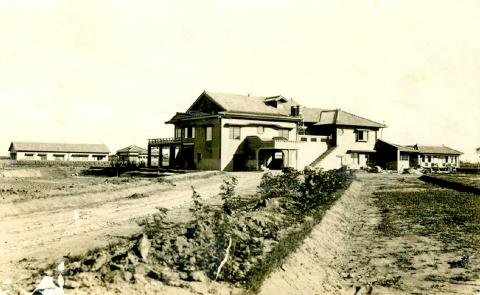The Kaohsiung Department of Cultural Affairs has announced tours of the Siaoyao Yuan (逍遙園) heritage site as well as artisan interaction events, allowing professionals and others a glimpse into restoration processes at the Japanese-built estate.
Siaoyao Yuan, which was built in 1939 and stands in the city’s Dagangpu (大港埔) area, was one of 11 estates established by Japanese monk Kozui Otani, and the only one in Taiwan, the department said.
Planned as a testing ground for the development of tropical agriculture, the estate, which is behind the Sinsing District (新興) Office on Jintian Road, was a peculiar blend of townhouse and private residence, the department said.

Photo courtesy of Ryuzo Nikaku
After World War II, the Ministry of National Defense commandeered the land to build a veterans’ village, it said, adding that a ministry policy of tearing down uninhabited veterans’ villages and building apartments put the estate’s fate in the spotlight.
The city government, academics and cultural conservation groups have worked for nearly a decade to have the building restored, it said, adding that work finally began in August 2017.
Japanese experts in plasterwork, woodwork and traditional shingles have been invited to tour the site and would demonstrate how the work should be done, while Taiwanese experts will observe, the department said, adding that it hoped the arrangement would promote Taiwan-Japan interaction on restoration techniques.
Local residents would be prioritized for the public tours, but people interested in cultural assets would not be excluded, the department said.
The tours will be led by professional guides, who will introduce the estate’s history, its construction style and “secrets” of the restoration processes that are otherwise not available to the public, it said.
Tour participants will be able to see the establishment in its entirety before others, it added.

US climber Alex Honnold is to attempt to scale Taipei 101 without a rope and harness in a live Netflix special on Jan. 24, the streaming platform announced on Wednesday. Accounting for the time difference, the two-hour broadcast of Honnold’s climb, called Skyscraper Live, is to air on Jan. 23 in the US, Netflix said in a statement. Honnold, 40, was the first person ever to free solo climb the 900m El Capitan rock formation in Yosemite National Park — a feat that was recorded and later made into the 2018 documentary film Free Solo. Netflix previewed Skyscraper Live in October, after videos

Starting on Jan. 1, YouBike riders must have insurance to use the service, and a six-month trial of NT$5 coupons under certain conditions would be implemented to balance bike shortages, a joint statement from transportation departments across Taipei, New Taipei City and Taoyuan announced yesterday. The rental bike system operator said that coupons would be offered to riders to rent bikes from full stations, for riders who take out an electric-assisted bike from a full station, and for riders who return a bike to an empty station. All riders with YouBike accounts are automatically eligible for the program, and each membership account

NUMBERS IMBALANCE: More than 4 million Taiwanese have visited China this year, while only about half a million Chinese have visited here Beijing has yet to respond to Taiwan’s requests for negotiation over matters related to the recovery of cross-strait tourism, the Tourism Administration said yesterday. Taiwan’s tourism authority issued the statement after Chinese-language daily the China Times reported yesterday that the government’s policy of banning group tours to China does not stop Taiwanese from visiting the country. As of October, more than 4.2 million had traveled to China this year, exceeding last year. Beijing estimated the number of Taiwanese tourists in China could reach 4.5 million this year. By contrast, only 500,000 Chinese tourists are expected in Taiwan, the report said. The report

Temperatures are forecast to drop steadily as a continental cold air mass moves across Taiwan, with some areas also likely to see heavy rainfall, the Central Weather Administration (CWA) said. From today through early tomorrow, a cold air mass would keep temperatures low across central and northern Taiwan, and the eastern half of Taiwan proper, with isolated brief showers forecast along Keelung’s north coast, Taipei and New Taipei City’s mountainous areas and eastern Taiwan, it said. Lows of 11°C to 15°C are forecast in central and northern Taiwan, Yilan County, and the outlying Kinmen and Lienchiang (Matsu) counties, and 14°C to 17°C